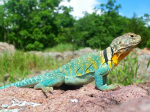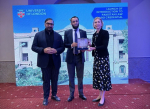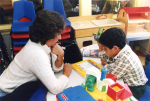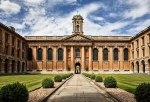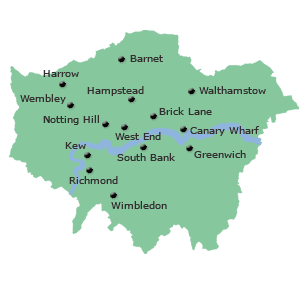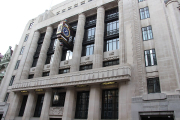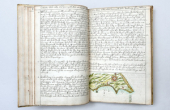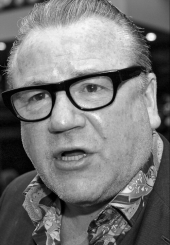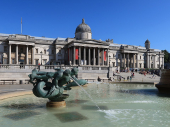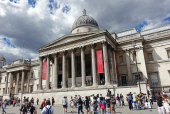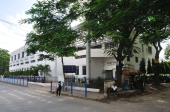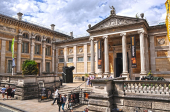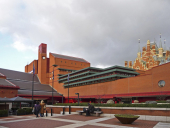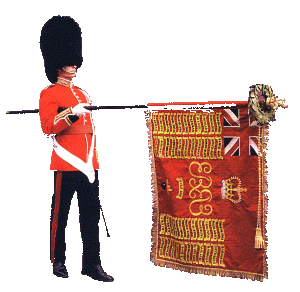
Recently a number of publications appeared in the Russian and Ukrainian press about Victor Nekrasov, devoted to the 105th anniversary of his birth on 17 June, 2016. He was remembered mostly as a Soviet writer and dissident, the author of one of the first truthful novels about World War II V okopakh Stalingrada, (In the Trenches of Stalingrad, 1946). I would like to focus my article on the role of Nekrasov in the heightening of public awareness about the Babi Yar massacre and the need to commemorate and memorialize the Holocaust in Kiev.
Victor Nekrasov was born in Kiev into a noble family in 1911. Nekrasov was a descendent of Russian, Italian and Swiss nobility. His grandmother Alina von Ern graduated from the Smolny Institute for Noble Girls and danced at the graduation ball with Tsar Alexander II. Nekrasov was quite proud of his noble ancestors and described them in his book Malen’kie portrety (Little Portraits).[1]
Victor Nekrasov’s mother Zinaida Nikolaevna Nekrasova (nee Motovilova, 1879-1970) was a distant relative of the poet Anna Akhmatova. Zinaida Nikolaevna was a very progressive woman for her time. While most noble women enjoyed a life of luxury and leisure, Zinaida decided to become a medical doctor. She studied medicine in Switzerland and worked for many years as a physician.[2] Victor remained close to his mother all of her life and Kievans often saw them walking together downtown. Less is known about Victor Nekrasov’s father, Platon Feodosievich, who died from a heart attack in 1917, when Victor was six years old. Victor’s mother and father separated when he was a small child. Zinaida Nikolaevna, with her two sons, Victor and his older brother Nikolai, lived in Switzerland and Paris before World War I and then in Kiev. Nekrasov’s father settled in Krasnoyarsk, where he worked as a bank clerk.[3] So perhaps Victor even did not remember his father.
In the 1930’s Nekrasov simultaneously studied architecture at the Kiev Civil Engineering Institute (now The Kyiv National University of Construction and Architecture (KNUCA)) and theater art in the Theater Studio at the Kiev Russian Drama Theater. In 1936-38 he worked as the architect and then as actor, director, and stage artist in theaters in Vladivostok, Kirov, and Rostov-on-Don.
In August 1941 Victor voluntarily signed up for the Soviet Army. As an actor, he had been excused from service, but he asked the authorities to send him to the front. His request was granted and he served as an engineer and deputy commander of a sapper battalion until June 1944, when he was seriously wounded in his right arm, and with a disability was released from the army. Nekrasov described his military experience in his autobiographical book V okopakh Stalingrada, (In the Trenches of Stalingrad, 1946). It was one of the first honest war novels in Soviet literature, which described the war and the battle of Stalingrad without romanticism, as difficult and dangerous work, where unnecessary risks taken by commanders could cost many soldiers’ lives. The novel was published in the journal Znamia and nominated for a Stalin prize. However, the chairman of the Union of the Soviet Writers Aleksandr Fadeev did not like the novel and crossed it off the list of nominees. (Fadeev was a romantic and Nekrasov’s realistic approach to describing the war contradicted his romantic view). But somebody restored the novel to the list. The only one person could challenge the power of Fadeed over the Union of the Soviet Writers was Joseph Stalin. Vsevolod Vishnevsky, who was the editor of the journal Znamia, told this to Nekrasov when his book received the Stalin prize for literature in 1947.[4]
The novel was republished in the Soviet Union many times in millions of copies and translated into 36 languages. The novel was made into the film Soldaty (Soldiers, 1956); Nekrasov was the author of the screenplay. The film received an award at the Soviet movie festival.
Nekrasov at this point had reached the zenith of his writing career in the Soviet Union. He became the Deputy Chairman of the Union of Ukrainian Writers and lived in the elite Passage house on 25 Kreshchatik Street (near Maidan, Independence Square). On the first floor of the Passage building were expensive stores and restaurants, on the other floors the Kievan elite lived: composers, architects, artists and actors. However, Victor Nekrasov’s honesty, noble manners and his political naivety did not fit “the Soviet way of life.” Like a Kievan Don Quixote, he began his courageous but futile fight for historical justice. Of course he was defeated, expelled from the country and deprived of his Soviet citizenship. His struggle was doomed from the start, but Nekrasov did not understand this for a while, and he hoped to improve the society where he lived.

Nekrasov was the first who began talk publicly against the authorities’ plan to turn Babi Yar into a stadium and demanded that a monument be built there to the victim of the massacre. Among Victor’s numerous friends were many Jews. Vika (as Nekrasov was called by his friends) initiated his friendship with Jews during the years of the most acute state anti-Semitism in the Soviet Union, during the anti-cosmopolitan campaign in the late 1940s-early 1950s. The well-known Kievan architect Avraam (Ava) Miletskii thus recalled how his friendship with Nekrasov began. In the beginning of the 1950s, Miletskii as a Jew was expelled from work on the Hotel Moscow project and he was not sure if he would be allowed to again work as an architect. At this difficult time, Victor Nekrasov came to his apartment to introduce himself. They talked all night about the amorality of current events, the shame of anti-Semitism, about other people’s and Miletskii’s problems. Miletskii wrote that this was the start of their long and deep friendship.[5] Nekrasov seems to have inherited his judeophilia from his mother. Zinaida Nikolaevna and Victor had many Jewish friends who perished in Babi Yar. So they took quite personally everything that was going on with Babi Ear.
Nekrasov recalled that in the post war years “some marginal persons crawled on the bottom of Babi Yar searching for either diamonds or gold tooth crowns.”[6] The Kiev authorities knew about these marauders, but could not stop them. The police arrested many of them, but others appeared. Perhaps the temptation for some local inhabitants to enrich themselves by digging up the remains in Babi Yar was stronger than their fear of the police. Then the Kiev authorities found a ‘solution’: they decided to completely liquidate Babi Yar. Historian Richard Sheldon wrote,
[I]n 1957 the question was officially discussed by the Ukrainian Central Committee [of the CPU], now under the leadership of Nikolai Podgorny. The committee decided not to erect a monument, and it also decided to efface the site altogether. Plans were made to build a sport stadium on the site and to build a dam at one end of the ravine.[7]
Nekrasov could not calmly watch as the local authorities tried to turn one of largest Holocaust sites in the Soviet Union into a stadium and park. He published in Literaturnaia Gazeta on 10 October 1959 his essay Pochemu eto ne sdelano (O pamiatnike pogibshim v Babiem Iaru v Kieve) (Why This Was Not Done (About the Monument for the Perished in Babi Yar in Kiev)). Nekrasov wrote that all Kievans had lost in Babi Yar either their relatives or friends, or acquaintances. Nekrasov said that he had visited the memorial to the victims at the Nazi concentration camp at Buchenwald. He asked in his article why there was no memorial to the victims of the Nazi regime in Babi Yar.[8] Nekrasov’s essay was published two years earlier than Yevgeny Yevtushenko’s famous poem Babi Yar (published in Literaturnaia Gazeta in 1961). Nekrasov wrote that “over 100 thousand men, women, children and elderly people” were killed in the Babi Yar massacre.[9] He demanded respect for the memory of the victims and expressed his outrage at the plans of the authorities to fill the ravine with mud and built a stadium there. Nekrasov’s essay was the first public demand to build a monument in Babi Yar. Why then did Nekrasov’s essay not become so famous as Yevtushenko’s later poem Babi Yar? Nekrasov was the first to publicly raise the question about building a monument in Babi Yar, but he did not mention in his essay that the vast majority of victims were Jews. Yevtushenko went further, he emphasized in his poetry the Jewishness of the victims of Babi Yar and identified himself with them. Why did Nekrasov avoid talking about the Jewishness of the Babi Yar victims in his essay? First of all, we don’t know for sure if Nekrasov did not mention Jews in his essay or if this was censored. If Nekrasov really did not mention that Jews were the vast majority of victims of Babi Yar, he may have thought that it would be easier to persuade the authorities to build a monument in Babi Yar without emphasizing this. Of course we can only guess about this, because the manuscript of the essay has not been found.
From the moment of this publication until his expulsion from the Soviet Union in 1974, Nekrasov talked many times publically about the need to build a monument in Babi Yar. The texts of his speeches have not survived, but some Kievans remembered them.
Nekrasov’s essay, Yevtushenko’s poem and Anatoly Kuznetsov’s Babi Yar: roman-dokument (Babi Yar: A Document in the Form of a Novel)[10] broke the silence about the Babi Yar massacre and raised the awareness of society about this tragedy. Thus the discussion about the need for a monument in Babi Yar came into the public sphere. Under pressure from public opinion in the Soviet Union and abroad, the Ministry of Culture of Ukraine called in 1965 for a “Closed competition of projects for monuments in memory of the Soviet citizens, soldiers and officers of the Soviet Army - prisoners of the war, who perished during the Nazi occupation of Kiev.”[11] Jewish victims were not mentioned in the call for the competition, because the Holocaust remained a forbidden topic in the Soviet Union. About sixty models of monuments were shown at an exhibition in the Architect’s House in Kiev in December 1965. However, none of the monument projects submitted for the competition of 1965 satisfied the jury.[12] The jury did not want a Babi Yar monument reminiscent of the tragedy of Kievan Jews. Irma, the daughter of the architect Iosif Karakis (his monument project was one of those submitted for the competition), attended the public discussion of the monument projects. Irma recalled that there flashed like a kaleidoscope anti-Semitic speeches written in advance and speeches of the condemned authors of the monument projects and writers, the majority of whom were Jewish. She wrote that Nekrasov gave a brilliant speech about the memorialization of the victims of Babi Yar. Then the film director Sergei Paradzhanov called for a minute of silence in the memory of the Babi Yar victims. In the silence that lasted more than a minute the widespread weeping of the Babi Yar victims’ relatives was heard from the audience.[13]
On the twenty fifth anniversary of the massacre of Kievan Jews on 29 September 1966, there was an unsanctioned meeting in Babi Yar, to which about one thousand people came. Nekrasov was one of the organizers of the meeting. A friend of Nekrasov, a director at the Kiev documentary film studio Ukrkinokhronika, Rafail Nakhmanovich, recalled that Nekrasov phoned his friends in Kiev and Moscow in advance, and asked them to come to the meeting in Babi Yar.[14] The Ukrainian dissident Ivan Dziuba confirmed this and said that Nekrasov invited him to participate.[15]
Russian and Ukrainian writers Nekrasov, Vladimir Voinovich and Ivan Dziuba came to Babi Yar and gave speeches at the meeting. They talked about the tragedy of the Jewish people, the need to struggle against anti-Semitism; while their friends, Nakhmanovich and the main editor of the studio, Gelii Snegirev, shot a documentary. This initiative of the local liberal intelligentsia was severely punished. According to the memoirs of the sculptors and architects Ada Rybachuk and Vladimir Mel’nichenko, the police arrived at the meeting at 9:30 am, wrote down car license plate numbers, made a list of the people who participated in the meeting, stopped the filming and dispersed the crowd.[16] The film was confiscated, the director Nakhmanovich fired, and Snegirev was demoted.[17] Nekrasov received a strict reprimand from the Communist Party (he had been a member of the party since the battle of Stalingrad) and later was expelled from the party, the Union of the Soviet Writers and ultimately from the Soviet Union itself.[18]
However two weeks later the authorities put a stone on the corner of the Dorogozhitsky and Mel’nikova streets near Babi Yar, with the engraving “On this site there will be a monument for the victims of Fascism during the German occupation of Kiev, 1941 – 1943.” [19] Thus the unsanctioned meeting in Babi Yar appears to have compelled the authorities to publically promise to build a monument in Babi Yar.
Nekrasov’s organization and participation in the meeting in Babi Yar, which the authorities called a “Zionist gathering,” was not the only case of his dissident activities. The writer also committed other “anti-Soviet” actions. One of them was the publication in the literary journal Novyi Mir (Volumes 11-12, 1962) of chapters from Nekrasov’s new book Po obe storony okeana (On Both Sides of the Ocean) about his travel to America. Nekrasov wrote that he was impressed by American skyscrapers, department stores and by the modern art in the Guggenheim Museum.
The Soviet leader Nikita Khrushchev criticized the publication, which was the signal for the persecution of Nekrasov. On 20 January 1963 in the newspaper Izvestia, an anonymous review of Nekrasov’s publication Turist s trostochkoi (Tourist with a Cane) was published, where he was called an apolitical consumer who fawned on American democracy and did not see the social contrasts and class struggle in American life. The author of this article, as became known later, was the Soviet journalist Melor Sturua, who wrote many malicious articles about America in the true spirit of hard core Soviet propaganda.[20] In the Soviet Union, a walking cane symbolized bourgeois life, so the title of review implied that Nekrasov was himself a bourgeois. The persecution of Nekrasov continued in Ukrainian periodicals. The Ukrainian satirical magazine Perets (Pepper, 10 (501)) published a cartoon featuring Nekrasov on its cover in May 1963.
Nekrasov was also criticized for signing collective letters in defense of dissidents and accused of being a dissident himself. His books were not published in the Soviet Union from 1971. Nekrasov was expelled by the Communist Party on 19 September 1972 for “having his own opinion that contradicted the general line of the party.”[21]
On 17-18 January 1974, KGB agents searched Nekrasov apartment for 42 hours. The KGB confiscated seven sacks of manuscripts, books, photographs, a typewriter and cameras. During this search Nekrasov’s manuscript Babi Yar was confiscated. Unfortunately, it disappeared along with the other materials somewhere in the KGB. After the search, the KGB interrogated Nekrasov many hours per day for six days.[22]

In March - May 1974, Nekrasov was detained by the police in Kiev and Moscow several times. Victor decided to leave the Soviet Union. Nekrasov wrote two letters to Leonid Brezhnev, where he stated that he could not tolerate any longer the KGB provocations and insults, and requested that he and his family be allowed to leave the Soviet Union for two years. Nekrasov’s request was granted, and Victor and his wife Galina Bazii left the Soviet Union on 12 September 1974.[23]
In 1979 the Soviet authorities deprived Nekrasov of his Soviet citizenship for ‘anti-Soviet’ activities. In emigration Nekrasov lived first in Switzerland and then in Paris. He worked at Radio Liberty and as assistant editor of the Russian émigré journal Kontinent (Continent) in 1975-82. Nekrasov continued to write prose and his memoirs. In his works and speaches Nekrasov returned many times to the topic of the Babi Yar massacre and its commemoration and memorialization. On the 35th anniversary of the Babi Yar massacre on 29 September 1976, Nekrasov came to Israel and gave a speech at the memorial meeting in Moshav Almagor on the Golan Heights.[24] On 28 September 1986, Nekrasov published in the New York Russian newspaper Novoe Russkoe Slovo his article Babi Yar 45 let (Babi Yar, 45 Years) where he talked about the Babi Yar massacre and the denial of the Holocaust by Soviet authorities. Nekrasov emphasized in his article the Jewish victims of the massacre. He wrote that in Babi Yar “were executed people of different nationalities, but Jews were killed only for their nationality.”[25]
Nekrasov died in Paris on 3 September 1987 and was buried in the Sainte-Geneviève-des-Bois cemetery.
Postscript: Victor Nekrasov’s Portrait
When Nekrasov left Kiev he was not allowed to take the art works from his apartment. Everything was left in place. Nekrasov left the apartment keys with his friend, the journalist Vsevolod Vedin, who subsequently lived there. Vedin suddenly died in January 1977 at the age of 52 and soon thereafter a KGB officer settled in Nekrasov’s apartment. The KGB officer threw out in the trash all of Nekrasov’s belongings that he did not want, including a portrait of the writer by the well-known Kievan artist Anna Kriuger-Prakhova.

Kriuger-Prakhova’s paintings are exhibited in the Tretyakov Gallery in Moscow, in the Kiev Museum of Russian Art and other museums. The artist participated in the decoration of the Vladimir Cathedral in Kiev, taught in several arts schools, and her works were shown at many exhibitions. She painted Nekrasov’s portrait in 1946. She knew Victor from prewar times when he often came to her apartment as the boyfriend of her daughter Nanina, with whom he studied at the Theater Studio.[26]

Nekrasov’s portrait was painted very warmly with fondness toward the writer. This perhaps especially irritated the new inhabitant of Nekrasov’s apartment. Before he threw out the portrait, the KGB officer shot it nine times with a pistol, presumably expressing his feelings toward Nekrasov. The next day Nekrasov’s friend Alik Petrik - passed through the Passage and saw on a pile of trash Nekrasov’s damaged portrait. He did not dare pick it up himself, but instead he phoned my relatives – the art collectors Semen Efimovich Reznikov and Zira Borisovna Tkachuk. Zira came by taxi, grabbed Nekrasov’s portrait and hid it in her apartment. Soon a KGB agent visited her neighbors and collected information about Zira: who was she, why did she pick up the portrait of the dissident Nekrasov and who were her visitors. In spite of her neighbors’ warnings, Zira and her husband Semen Efimovich hid Nekrasov’s portrait until Perestroika, and then had the portrait professionally restored and proudly hung it in their apartment. Unfortunately, after their death, Nekrasov’s portrait has apparently disappeared. A publication has suggested that Nekrasov’s portrait was passed on to Semen Reznikov’s heirs.[27] Semen Efimovich and Zirka Borisovna did not have children, so it is not clear who inherited the portrait. Hopefully some reader of this article will help solve this mystery. Nekrasov’s portrait should be in one of the Kiev museums. The portrait should belong to the city where this wonderful person and writer spent most of his life.
[1] Victor Nekrasov, Malen’kie portrety. Elektronnaia biblioteka RoyalLib.Com, 2010-2016. http://royallib.com/read/nekrasov_viktor/malenkie_portreti.html#0
[2] Svetlana Bakhareva, “Motovilovy v “dome-komode”: iz istorii sem’i V.P. Nekrasova,” http://nekrassov-viktor.com/Family/Baxareva-Svetlana-Dom-komod.aspx
[3] http://nekrassov-viktor.com/Family.aspx
[4] Conversation of Victor Nekrasov with Alexander Galich on Radio Liberty, Program “Kul’tura, sobytia, liudi,” 23 January 1976, http://www.svoboda.org/content/transcript/24232994.html
[5] Avraam Miletskii, Naplyvy pamiati (Jerusalem: Filobiblon, 1998), 110.
[6] Babi Yar: chelovek, vlast,’ Istoriia. Dokumenty i materialy, compilers Tatiana Evstaf’eva, Vitalii Nakhmanovich. (Kiev: Vneshtorgizdat Ukrainy, 2004), 188; Jan Gross described similar events in Poland, when Polish peasants dug up the ashes of Treblinka, searching for gold and precious stones, and even posed for photographs. Jan Tomasz Gross with Irena Grudzinska Gross, Golden Harvest. Events at the Periphery of the Holocaust (Oxford, New York: Oxford University Press, 2012).
[7] Richard Sheldon, “The Transformations of Babi Yar,” in Soviet Society and Culture. Essays in Honor of Vera S. Dunham (Boulder and London: Westview Press, 1988), 133.
[8] Victor Nekrasov, “Pochemu eto ne sdelano?” in Pamiat’Babiego Iara. Vospominaniia, dokumenty, compiler Ilia Levitas. (Kiev: Evreiskii Sovet Ukrainy, 2001), 232-233.
[9] Ibid.
[10] Anatoly Kuznetsov’s Babi Yar: roman-dokument was first published in a censored form in 1966 in the journal Iunost’ (issues 8-10).
[11] Vadim Kipling, “Ushel, ostaviv zhizn‘ v kamne, ” Ekho, 01/03/2013
http://exo.net.ua/arkhiv/2423-2013-01-03-09-29-52
[12] Evgenii Olenin, “Zabytyi konkurs 65-go goda,” http://archive.is/Dja2
[13] Ibid.
[14] Mikhail Samuilovich Kachan, “Miting v Babiem Iare 29 Sentiabria 1966 g.” http://www.proza.ru/2014/05/21/112
[15] Ibid.
[16] Ada Rybachuk, and Volodymyr Mel’nychenko, Koly ruinuet’sia Svit... (Kyïv: Iurinform, 1991)45.
[17] Vladimir Potresov, “Vozvrashchenie Nekrasova,” in Victor Nekrasov. Zapiski zevaki (Moscow: n.p., 2003), 21; Elektonnaia Evreiskaia Entsiklopedia, s.v. “Babi Yar,” http://www.eleven.co.il/article/10370
[18] Potresov, “Vozvrashchenie Nekrasova,” 22.
[19] Babi Yar - I. http://berdichev.org/babi_yar.htm.
[20] http://nekrassov-viktor.com/Turist%20s%20trostochkoy.aspx
[21] V. A. Potresov, “Vozvrashcheniia nekrasova”, 22.
[22] Alexander Parnis, “Tragedia Babiego Iara. Ob odnoi nezakonchennoi knige Viktora Nekrasova,” http://jennyferd.livejournal.com/1359870.html
[23] Viktor Kondyrev, Vse na svete krome shila i gvozdia. Vospominania o Victore Platonoviche Nekrasove, Kiev – Parizh 1972-87 (Moscow: ACT Astrel’, 2011), 84-87.
[24] Alexander Parnis, “Tragedia Babiego Iara. Ob odnoi nezakonchennoi knige Viktora Nekrasova,” http://jennyferd.livejournal.com/1359870.html
[25] Victor Nekrasov, “Babi Yar 45 let,” Novoe Russkoe Slovo, 28 September 1986, http://jennyferd.livejournal.com/1359870.html. Roma were also killed in Babi Yar due to their nationality, but perhaps Nekrasov was not aware of this.
[26] Viktor Nekrasov v izobrazitel’nom iskusstve. Anna Kriuger-Prakhova, http://www.nekrassov-viktor.com/Art/Nekrasov-Kryger-Praxova.aspx
[27] Ibid.












